Sizing a pump? First, decide what type of pump you need.
So you’re building a system. You’re ordering materials, and all that’s left for you to do is to order a pump.
You open the web browser, search for hydroponic pumps, and there are:
- sump pumps
- air pumps
- submersible pumps
- inline pumps
- peristaltic pumps
Which kind and which size should you get?
Pump sizing varies based on whether you’re using hydroponics or aquaponics, your overall system size, and the type of hydroponic or aquaponic system you’re running (the types covered in this post are DWC, NFT, media bed, Bato bucket, and ZipGrow Towers).
Read on to learn about different types of pumps.
Inline vs submersible pumps
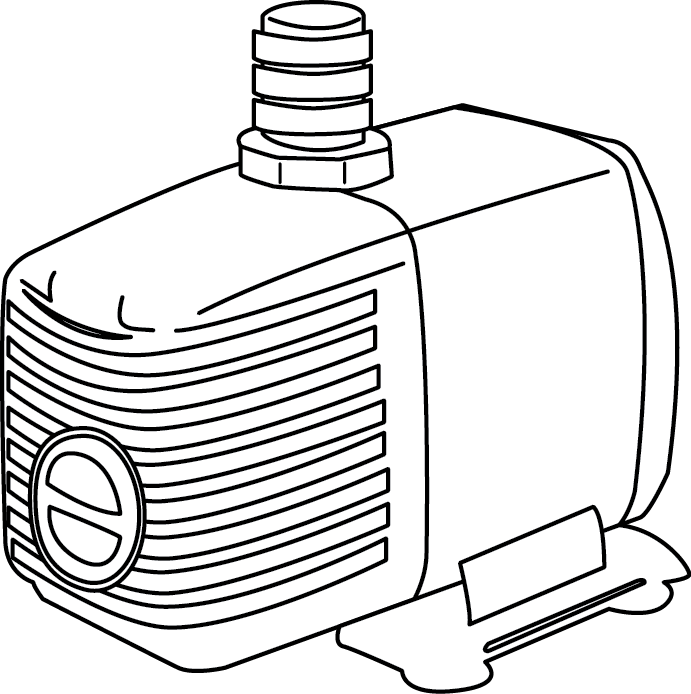 The two main categories of pumps that you will be choosing from are inline and submersible pumps.
The two main categories of pumps that you will be choosing from are inline and submersible pumps.
Submersible pumps are cooled by the water and sized in GPH. These sit directly in the water of a tank or gutter and pump water through a fitting (and hose that you attach) from the top of the pump. Submersible pumps are limited in power and are only suitable for systems with a total GPH need of 1200 or less. This fits most hobby systems, display systems, and very small commercial systems.
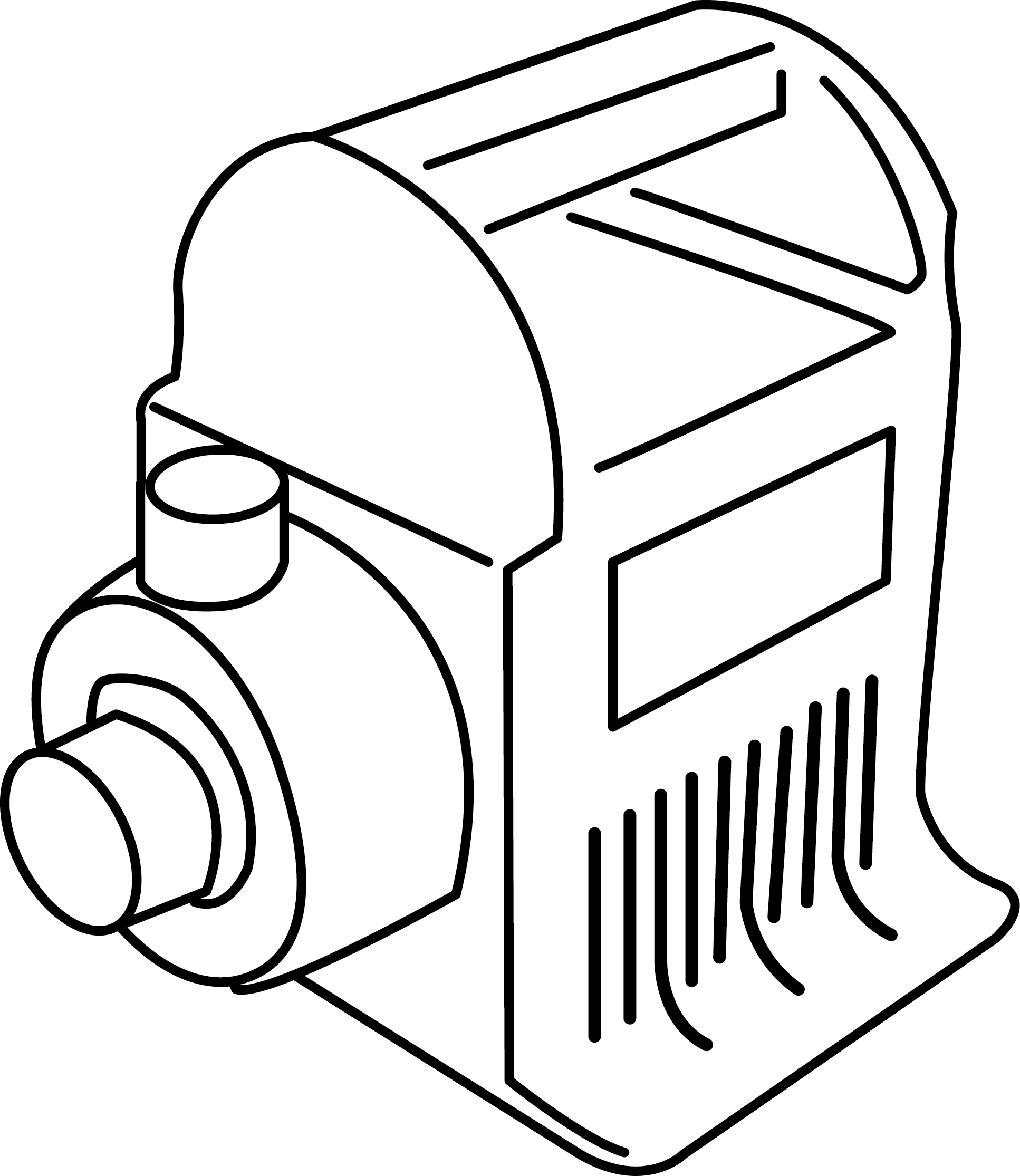 Inline pumps are air-cooled, sit outside of your tank, and are typically suited best for larger (50 or 100+ tower) operations. Inline pumps typically have more power, which is measured not in the volume of water that they can move like submersible pumps, but in horsepower, HP.
Inline pumps are air-cooled, sit outside of your tank, and are typically suited best for larger (50 or 100+ tower) operations. Inline pumps typically have more power, which is measured not in the volume of water that they can move like submersible pumps, but in horsepower, HP.
The term “sump pump” refers to a pump that moves water from one sump tank to another or is used for turbulence and mixing nutrients inside one sump tank. These help with consistency and can help with oxygenation. We use submersible pumps for this.
An air pump may be used to pump low volumes of air at high pressure, usually for aerating the water. Aeration is important for supplying oxygen to root zones and avoiding anaerobic decomposition. Seedling carts with fertilizer solutions may benefit from an air pump, for example.
Peristaltic pumps are small pumps that are most often used in auto-dosing. Most auto-dosing systems come with the pumps.
3 steps to sizing a pump
Finding the right sized pump isn’t half as complicated as it might seem! We’ve put together easy formulas to use—one for hydroponic growers, and one for aquaponic growers. In order to determine the best pump for your system, you’ll need to do three things:
-
- Calculate the GPH (gallons-per-hour) that your pump will be moving
- Measure the head height of your system
- Combine these two values using the chart that comes with the pump
If you start feeling overwhelmed at any point during this post, just ask a question in the chat box on the right side of the screen!
We’ve put together two tables for both hydroponics and aquaponics to help anyone sizing a pump for your system:
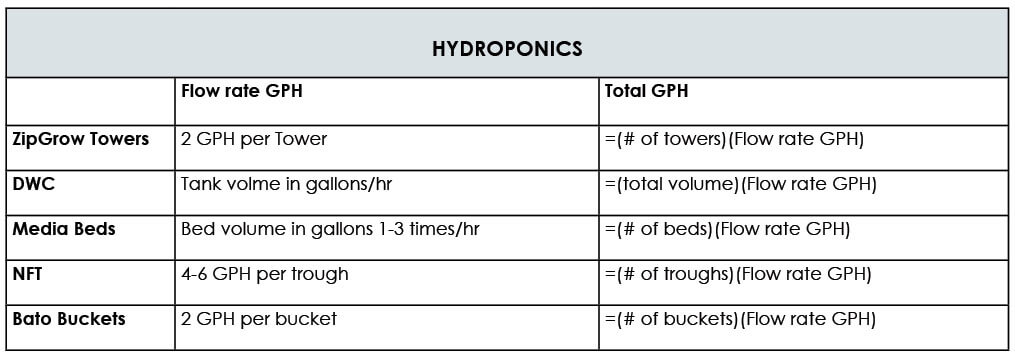
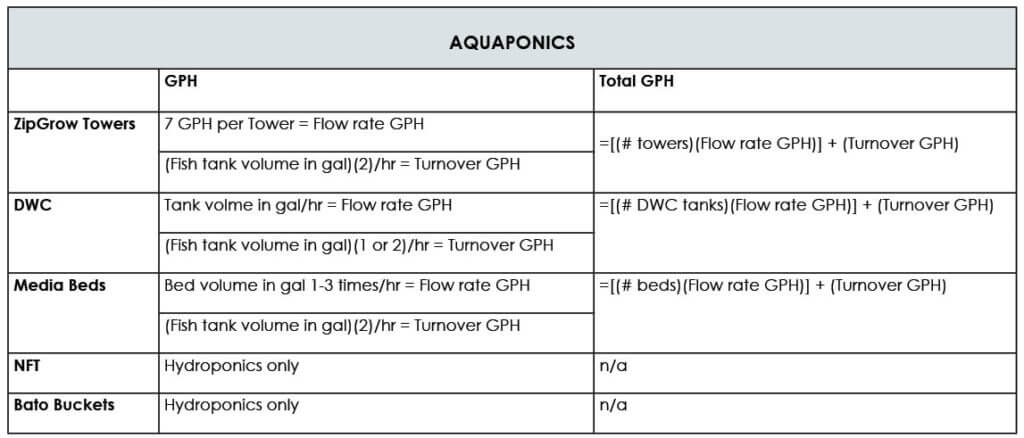
Let’s go through the 3 steps to sizing a pump; we’ll use a ZipGrow Tower system as an example.
Step 1: Calculate the required GPH
Pumps will almost always have a gallons-per-hour (GPH) rating that tells you how many gallons of water that pump will move every single hour. Obviously, places that favor the metric system will use liters per hour. (You can use the same equations, just remember that if you change one unit you have to change all of them.)
Calculating GPH for hydroponics
Your total GPH is the flow rate times the units with that flow rate.
In hydroponics with ZipGrow Towers, you want to run two gallons of water through each tower every hour. This means that the number of gallons per hour is essentially the number of towers, times 2. So you end up with a gallons-per-hour (GPH) for hydroponics equation like this: (where t=towers)

This is the equation for a ZipGrow system. If you had a DWC system, on the other hand, the equation would be (total volume)(flow rate GPH)=total GPH
*Tip: You’ll also have a bit of extra water in your sump—a good rule is to add fifty gallons for the sump.
Example (DWC): DWC hydroponic system with two 500 gallon tanks.
Example (Media bed): 400-gallon media bed system with a 2/hr turnover and a 60-gallon fish tank.
Calculating GPH for aquaponics
Now imagine that our example is ZipGrow Towers in aquaponics. In aquaponics, you’ll want to run between seven and ten gallons of water through each tower every hour. Since you’ve got the fish tanks as well, you also need to factor in the fish tank gallons. You’ll also be turning over the fish water twice every hour, so the gallons per hour for aquaponics equation looks like this: (where t=towers)

This is the equation for a ZipGrow system. If you were running a media bed system, the equation would be [(number of beds)(Flow rate GPH)] + (Turn over GPH) = Total GPH
Step 2: Measure system head height
Because almost all aquaponic or hydroponic growers need to move water upward, you’ll need to also understand how efficient your pump is at different heights. Whether you’re using a traditional horizontal grow bed model or NFT or ZipGrow Towers, you’ll still need to move water vertically from your fish or nutrient tank to your beds, troughs, or Towers. To compensate for the height, we use a measurement called head height.
Head height is the distance between the top of your grow bed (or ZipGrow Tower) and the top of the water in your tank. You won’t need a calculation for this. Just measure the length between the water line in your sump and the exit point of your irrigation (in a ZipGrow system, the exit point is the drip lines above your Towers).
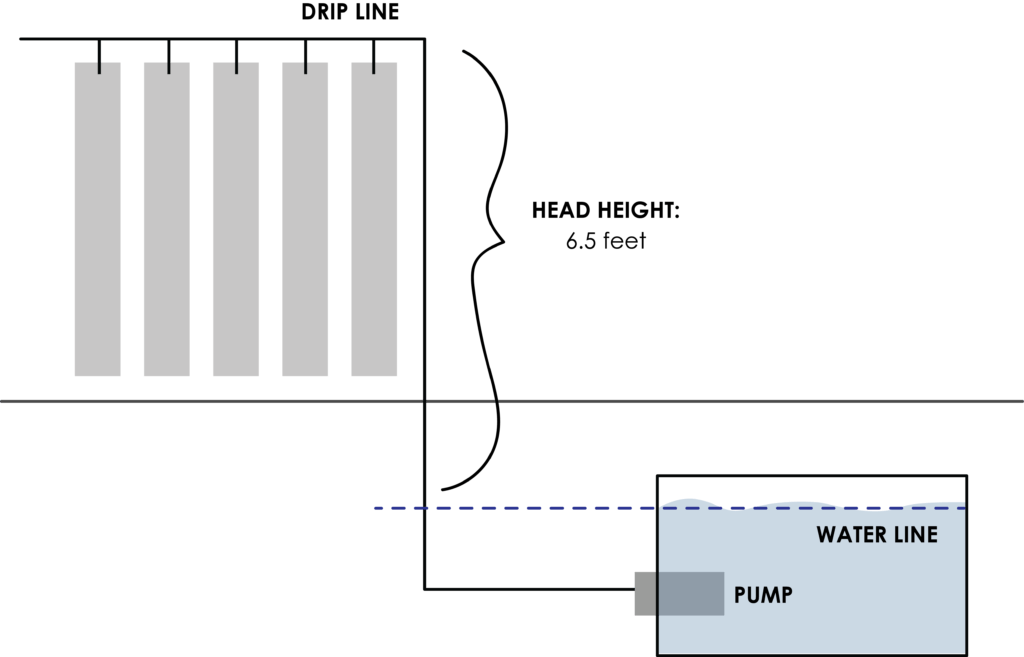
For example: If you have an in-ground sump and the water line is one foot below ground level, and you’re irrigating your Towers 5.5 feet above ground, your head height is 6.5 feet.
Step 3: Combine GPH and head height
All pumps will come with a chart similar to this one:
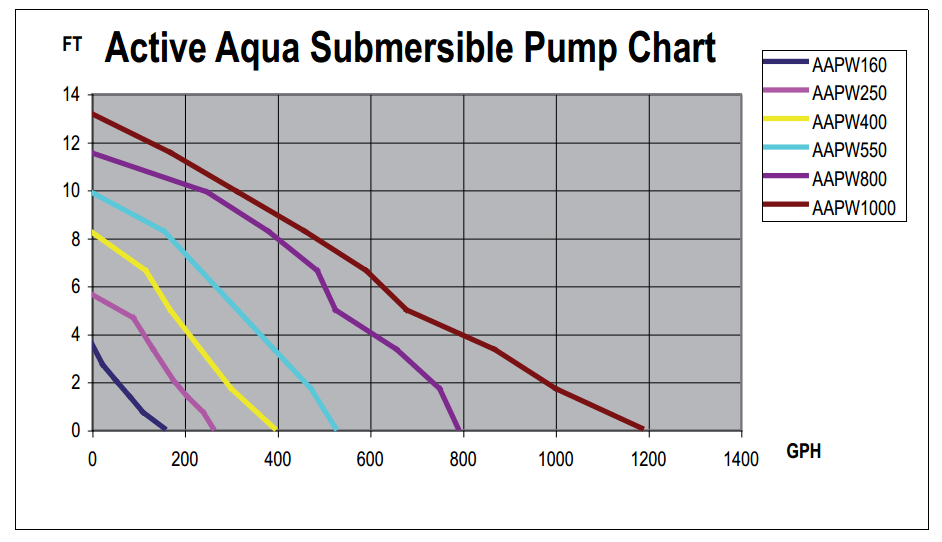
This chart is going to be your cheat sheet. This one specifically matches the strength of Active Aqua pumps, and other pump brands will come with their own chart. (Make sure you’re using the right chart for your type of pump! Inline pumps and submersible pumps function differently.)
Using the GPH you calculated and your head height, find the pump that matches your needs. Pump efficiency at different head heights is almost never a linear relationship.
Sizing an inline pump: use the same 3 steps
Inline pumps will also have GPH or GPM listed and come with a curve that shows the GPH and head height intersections. This means that sizing an inline pump requires the same steps as sizing a submersible pump.
One note is that if you’re running a large operation, then you’ll probably want to order a pump with extra power so that you don’t have to buy a new one when you scale up.
Remember: Systems vary!
When choosing a pump, keep in mind that our recommendation of turning over your entire system volume at least twice per hour is a recommendation. If you shoot a little long or fall a little short of this recommendation, everything will probably be just fine. Just remember that every aquaponics or hydroponics system out there varies considerably. Whether it’s the plumbing, system design, grow media, etc., every system is different and required GPH can vary because of it.
If you are growing aquaponically, you must be exchanging your water fast enough to maintain a good level of dissolved oxygen in your system. This is crucial to healthy fish!
Plan on 15–30% loss in efficiency
When researching GPH and various head heights for your own application, remember that you’ll be moving water through what could be quite a long length of hose. That said, the further your system volume travels, the lower your pump’s efficiency will be, and that could mean a decreased GPH or overall system performance.
While it’s possible to do the efficiency calculations here, it’s much more simple just to eyeball it and calculate anywhere from a 15% to 30% loss of efficiency (this, of course, depends on your plumbing and system design).

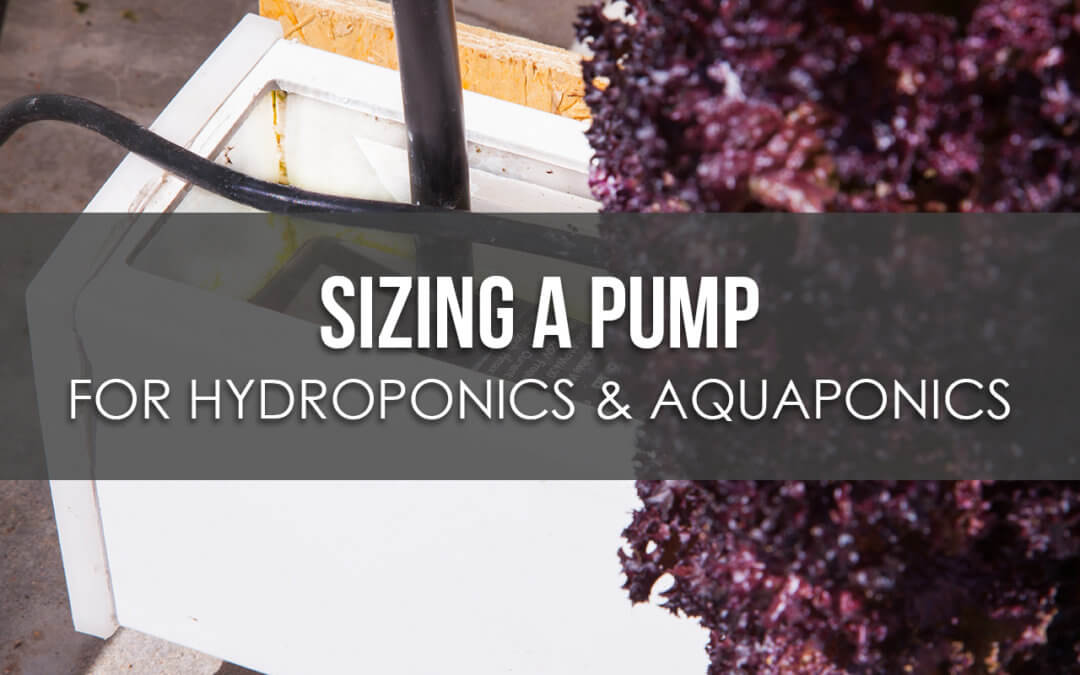

Thanks for share this information.
Some good information, but could you please talk about the tacos? I think it very offensive that you discriminate against tacos by not even mentioning them in this article. #tacolivesmatter
Thanks for bringing this to our attention! After thoughtful consideration, the team here can all agree that sizing your pump appropriately allows you to grow better, crisper, more delicious lettuce for topping the greatest food ever invented- the taco. So make sure your sump is correctly sized or tacos everywhere will suffer.
Has to be the best entertainment so far today. As a taco lover, I couldn’t agree more. The info here is really helpful.
I was unaware that there are so many different kinds of pumps. Being a student interested in post-apocalyptic scenarios, this is vital information to figure out how to pump water out of the ground. With this, you shouldn’t have to worry about purchasing water! Thanks for all the information!
the info about calculating pump delivery head is incorrect. pump head is measured from the outlet of pump to the highest point your pumping too also known as delivery/lift head. suction head is also important for inline pumps as they are designed to only lift water from a certain maximum depth (depending on pump model/type all are different)the deeper the lift below pump the lower the flow. all pumps work best when source is above the inlet of pump example pump is same height as bottom of water tank. remember to allow extra for flow drop from fittings,hose & bends in hose also a hose bend of 90degrees has less flow drop than a 90deg elbow fitting. so the less fittings, hose etc the better. i do pump repairs and maintenance for a living.
Hi! You mention flow rate in a few of your examples, but you don’t elaborate on how to extract this parameter. Hoping you could elaborate on this?
Thanks!
Hey Gabe, to find out your flow rate, look at the table that lists “flow rate GPH” and “total GPH”. The total GPH is the number that you plug into the second part of the equation.
Are there solar pumps available for aquaponic systems? If so, can you make suggestions?
Thank you for the useful video’s and information. I need some help if you will be so kind. I bought a 225 Gph, 5 bar inline pump, head height of 30 meter. Is this more ideal for a hydroponic or aquaponic system? I would like to start with a one pump split flow, Zip Grow, whether hydroponic or aquaponic system. Is this pump too strong for a hydroponic, because I only need 5.6 ft head height? I would like to start simple, say with a hydroponic and extend later, but I assume i need to reduce some pressure and can do that with aquaponics?
Hey Hendrik, it’s not necessarily a bad thing to get an oversized pump. If it’s too much at first, you can control flow with valves. Plus if you want to expand the system down the road, you don’t have to order another pump.
Does controlling the flow with valves hurt the pump?
Hey MJ, not in most situations – it will just reduce pump efficiency.
So I have a spring that runs at about 50 gallons per day that I would like to run into a 500 gallon tank and as the start of my hydroponic system. Everything I’ve read looks like you need a complete turn over of the water, in this case 500 gallons, every hour! What is the down side if I use just the flow from my spring?
Hey Robby, to clarify, turnover refers to cycling your water through your system and filtration rather than draining and replacing. 50 gallons a day will probably be fine to top it off, depending on system size, but it’s a good idea to keep a reservoir full in case you need a lot of water, fast (say you have a leak or contaminated water).
It’s good to have a water test done when you’re starting a system so you can spot potential issues. If your water comes from limestone, for example, you could have pH issues.
Nice post. I learn something new. Thank you for sharing such a useful information.
I have about around a 40 gallon tank and we have a small grow bed that’s about 30x12x6. I’m completely lost in what size pump I should get. I want it to be a submersable pump. I don’t want it to be too much or water will get everywhere and I don’t want it to be too less or else the water won’t be able to get up to our grow bed. What should I get??
Hi Madalyn,
A good set of pump instructions will tell you how many gallons per hour a pump will transfer water at specific heights. Use that number and the volume of your grow bed to find out how fast it will fill up. Compare that to how fast it drains and you have an equation that doesn’t sum to spillage.
I am trying to find out what size pump I need for a 55 gallon cichlid tank? I am using a 5 gallon DYI canister that sits under the tank. The pump will connect to the output line at the bottom of the canister and needs to lift the water apx 4 feet.
Hello,
For something like this, you want 300 gallons-per-hour minimum at 4 feet head height. Going larger (like the one linked here) allows for restrictions in tubing and the filter that will lower flow rate.
If I am using rows of DWC beds that total 55 Cubic Meters or 1943 Cubic Feet, how large of a sump tank do you recommend?
Travis,
This should put you on the right track:
http://www.aquaponiclynx.com/how-to-size-your-sump-tank
Good luck!
Hello my name is Scott I live in Vietnam I am SCOTISH and married with child , I am most enthusiastic of the venture I have built a pond in countryside unfortunatly family don’t understand all iam attempting to show which I believe ethically and morally correct I ask if you would give me advice on best plants with which type of fish the correct plants and natural food for paticiular fish yes I ask many but I also do with much thanks for you attention even better advice yours thankfully Scott watson
Hi there Scott,
This really depends on many things. For example, if you will be selling the crops or just using them for yourself. There are not certain crops we recommend in particular but I do recommend checking out the course, 1010: Hydroponic and Aquaponic Crops. You can purchase the PDF version here. I also recommend trying out Upstart’s free, seven-day trial to see if any of our other courses could benefit you. I hope this helps!
Hi It is very good sharing of knowledge for beginners like me. Do you have a power point presentation on the step by step approach on the sizing of pumps, the details of the end fittings and their technical names for me to approach a plumbing shop and ask for the specific item to make the bill of materials and the cost working. I would like to know more about the connections and the circuits for plumbing lines. in case you are willing to share the information please help.
Hi Ramesh,
Unfortunately we do not have exactly what you are requesting at this time. However, we do have many more resources on plumbing that you may find useful. ‘How to be Effective at Plumbing Flexible Tubing’ can be found here. If you go to the bottom of this post, you will also see the links to the rest of our posts in The Plumbing Series. I hope this helps!
I am planning to re-start my NFT hydroponics system using 12 or 24v solar power. Here pump selection becomes fairly critical, basic flow rates and head info do not supply enough accuracy, and guessing efficiency loss incorrectly can prove expensive.
I will be running 40 gullies, supplied by 40 x 4mm x 300mm long feeder tubes, hopefully running at 1 litre/min. This will all be at the end of a total of 18m of 25mm poly pipe, which will utilise 10 tees and 2 elbows. Head will be 1.5m. What I need is some sort of formula to tell me what size friction loss this system will create, which I will then need to add to the system head to select a pump with sufficient flow rate at that head.
Also, Chris [Feb 18, 2017] mentions head as being from the pump outlet to delivery point. Still slightly incorrect, especially when working from a reservoir or tank and the pump is lower than the surface. The head is then the difference between the reservoir surface and the delivery point, due to the pressure of the water above the pump. This will not vary whatever height the pump is within the reservoir depth range. A handy point to consider if you wish to use a high volume, low head pump.
Theo,
A simple solution is to go larger than needed on the pump flow and head height. You can then regulate the flow out of the feeder tube via a 1 liter/minute clogless drip emitter.
I have set up a bato bucket system and we have 8 buckets on the line. I have 2 gph drip emitters and a 250 gph pump. The head height is no more than 3 ft and I am getting nothing out of my emitters. Everything is nice and tight, water is going through the 1/2″ pipe and if I pull an emitter out we have water squirt out. Any help?
Carlie,
It could be the brand or the style of the emitter. Some—like the “clogless” types—require a certain amount of pressure in order to achieve any flow at all.
I simply require a very low GPH pump for an indoor mini sprinkler system. I have a small grow room that requires constant attention and somewhat ties me to the house. My idea is to design a watering, lighting and circulation system that I will be able to control from my phone while I’m away. It will include 2 cameras that will allow me to observe and make adjustments as needed. (i.e. additional watering.) my plan was to use a fish tank pump and tubing for the system. I’m also considering trying some flow regulators for sprinkler systems. The only problem so far is that I cannot find a low enough GPH pump to run with the system. I’m concerned that the 80 GPH pumps I’ve found will either fail from resistance or pop the connections. Any thoughts on this would be wonderful. Thanks.
It would be kind if you can advice to resolve below problem, I have gone through many Youtube Video but not able to find right solution.
I replanted plants post it grew 3-4 inch ( in 2 weeks time ) from seeding tray to Vertical NFT system. Its been 10 days its planted in NFT but the Roots are not growing. Roots which are shooting out from the net cup more than 1 cm are turning brown and dying.
I also tried replanting the plants which I was growing using kratky methord, here in 2-3 days I would see roots growing upto 1-2 inch in short peiod of time. I took out the net cup from Kratky system and planted to Vertical NFT system but after 2-3 days all roots turn brown and few plants started dying.
If you can help by suggesting what need to be done to solve above problem.
Details about my Vertical NFT System
• Dimention : Single unit with 6.5 feet height with 18 Cups. Each net cup is of 2 Diameter.
• Grow Medium : Cocopeat
• Sunlight : I have built this setup in my apartment balcony hence most of the time plants do not get direct sunlight however my balcony receive decent indirect r light
• Pump Flow Rate : flow rate of 1.2 Gallon ( 4.8 Liter ) per hour
• Water : 550 TDS, PH : 6.5
• Frequency of running the pump / watering : I have been running my pump every 30 min interval for 45 Min. ( On Duration : 45 Min, Off duration : 30 Min )
• Current Temperature in my City ( Bangalore, India ) : Average 25 Degree Celsius which got up to 35 Degree Celsius in afternoon ie b/w 4:30 PM to 5:45 PM when direct sunlight falls into plants , Humidity 73%
• Currently : Plants are 3-4 Inch tall however non of the plants roots have grown outside the netcup.
Today I have changed the schedule to run the pump. I’m not sure of that can save my plants. While we are all quantile due to COVID – 19 these plants are my only companion and its hard to see them dying.
08-00 PM-08-15 PM
09-15 PM-09-30 PM
10-30 PM-10-45 PM
11-45 PM-12-00 AM
01-15 AM-01-30 AM
03-00 AM-03-15 AM
04-30 AM-04-45 AM
06-15 AM-06-30 AM
07-45 AM-08-00 AM
09-15 AM-09-30 AM
10-45 AM-11-00 AM
11-45 AM-12-00 PM
12-45 PM-01-00 PM
01-45 PM-02-00 PM
02-45 PM-03-00 PM
03-45 PM-04-00 PM
04-30 PM-04-45 PM
05-15 PM-05-30 PM
06-00 PM-06-15 PM
07-00 PM-07-15 PM
Thanks
Alok
Hi Alok John,
Are the roots in your NFT system reaching the nutrient solution? If they are not reaching the solution it’s possible that they are simply not getting the nutrients and the water they need. If you need more help, please feel free to email support@upstartuniversity.net.
Hi,
I see the info regarding the needed gph but how often are these pumps running? If my pump will prove the required 2gph to my zip grow towers in 20 min, is the pump shut off the other 40 min per hour? If so, how does this work, is there a timer that allows the pump to run xx minutes per hour? Or, does the pump run 24hrs per day with some type of restriction to only allow 2 gph to each tower?
Is there any for DFT Hydroponic System ?
Thank you for this amazing initiative on training beginners on hydroponics. I am trying to figure out the flow rate required for a big hydroponics raft system. We have 5 float raft systems of the size of 88ft(L) x 20ft(W) x 16in (D). We aim to grow lettuce in these systems. Where can I find information regarding finding an ideal flow rate for the system and how to size a pump for the same system. We intend to keep these systems connected to the same nutrient tank.
Thank you for your help.
Why at the GPH Table for aquaponics there is “Hydroponics only” mention at NFT? NFT is the biggest part of my system (a mix of NFT, EBB and DWC)
excellent blog, Thank you for posting.
incredibly useful and helpful blog, Thanks for the post